In short
The Tamron Di II SP 17-50mm F / 2.8 VC is a balanced fast universal zoom lens for cropped cameras. An alternative for more expensive Nikon DX AF-S Nikkor 17-55mm 1: 2.8G ED IF SWM и Canon Zoom Lens EF-S 17-55mm 1: 2.8 IS USM.
Tamron Di II SP 17-50mm F / 2.8 VC is a significant upgrade to an older version Tamron 17-50mm F / 2.8 XR Di II LD Aspherical (IF). The main innovation is the availability of the image stabilizer Tamron VC.
Tamron Di II SP 17-50mm F / 2.8 VC is available only for Nikon (model B005 N II) and Canon (model B005 E) cameras.
In general, the Tamron Di II SP 17-50mm F / 2.8 VC is on par with a similar third-party lens - Sigma DC 17-50mm 1: 2.8 Zoom EX OS HSM,
The Tamron Di II SP 17-50mm F / 2.8 VC has been in my personal use for a long time as a 'workhorse' for crop cameras and left a good impression.
Key Features of Tamron Di II SP 17-50mm F / 2.8 VC:
| Review Instance Name | The lens barrel says 'Ø 72 Di II Tamron SP 17-50mm F / 2.8 B005 Made in Japan 110612' |
| Basic properties |
|
| Front Filter Diameter | 72 mm |
| Focal length | 17-50 mm EGF for Nikon DX cameras is 25.5-75 mm |
| Zoom ratio | 2.94 X (often rounded to three) |
| Designed by | for Nikon DX cropped digital cameras |
| Number of aperture blades | 7 rounded petals that form a fairly even hole |
| Tags | focusing distance in meters and feet, focal lengths for 17, 24, 35, 50 mm, hood attachment mark, bayonet mount mark |
| Diaphragm | from f / 2.8 over the entire range of focal lengths to f / 32. The lens does not have an aperture ring (G - lens type for Nikon cameras) |
| MDF | 0.29 m, maximum magnification ratio 1: 4.8 (at a value of 50 mm focal length) |
| The weight | 570 g |
| Optical design | 19 elements in 14 groups of which:
Clickable Image |
| Lens hood | Supplied petal hood, AB003 |
| Manufacturer country | MADE IN JAPAN (but there are lenses made in China) |
| Price | |
| Period | From September 17, 2009 to the present day |
Assembly
Tamron Di II SP 17-50mm F / 2.8 VC is made only in Japan. To the touch the lens is pleasant, strong, weighty. The retractable frame of the body ('trunk') consists of one section, which is strong enough, without any backlash. To the touch Tamron Di II SP 17-50mm F / 2.8 VC is much better than its previous model Tamron 17-50mm F / 2.8 XR Di II LD Aspherical (IF).
The lens has metal bayonet mount. The zoom and focus rings are rubberized. Changing the focal length runs smoothly. The zoom ring can rotate quite tight for the first time.
There is a bayonet mount mark and a mark on the case for quick installation of the hood. The lens uses a plastic hood, which is fixed in special grooves located near the front lens of the lens. The hood can be installed in the opposite direction for transportation. In this position, access to the focus ring at 17 mm focal length is lost. When you change the focal length, the lens hood moves with the front of the lens.
When changing the focal length, the rear lens moves in the middle of the lens body like a pump - it draws in and pushes out air. This behavior of the rear lens is called 'vacuum cleaner effect', which can increase the amount of dust that accumulates in the camera.
The number of diaphragm blades is 7 pieces. At the same time, they are slightly rounded and already form a heptagon on strongly covered diaphragms.
For Tamron Di II SP 17-50mm F / 2.8 VC, the direction of rotation of the zoom and focus rings coincides with the direction of the original Nikon DX AF-S Nikkor 17-55mm 1: 2.8G ED IF SWM.
It is believed to be a lens from the Tamron SP professional line. Many professional lenses use the classic 77 mm filters, 72 and 82 mm - less often. The Tamron Di II SP 17-50mm F / 2.8 VC has 72mm filters.
Despite the good build of the Tamron Di II SP 17-50mm F / 2.8 VC, the overall reliability of the lens is very much inferior to the original metal super-lens Nikon 17-55 / 2.8G.
Repair masters claim that the internal implementation of the lens assemblies is not very good. Personally, I was faced with the fact that with a light blow, the section on which the focus and stabilizer switches are mounted broke completely. This section is made of very thin prastik.
Lock 'LOCK ′
Frame (trunk) at Tamron Di II SP 17-50mm F / 2.8 VC does not spontaneously change its size under its own weight (perhaps this can only begin with time). To prevent future inconveniences, a focal length switch 'LOCK' (the so-called 'lock') is present on the lens body, which tightly locks focal length at a value of 17 mm.
To fix the trunk of the lens, you must first set the 17 mm focal length. Near the button there is a drawn arrow that indicates in which direction the switch should be moved to lock the lens.
The switch is located in a convenient place - under the thumb of the left hand, so the lens can be quickly and comfortably 'removed from the lock' before starting shooting.
The effect of spontaneous changes in focal length (trunk creep) in this lens is quite noticeable.
Focusing
For focusing, the lens uses a micro motor that is noisy. Tamron Di II SP 17-50mm F / 2.8 VC will automatically focus on all Nikon DX cameras.
When used on a camera Nikon D40, D80, D200, Nikon D90 with unpretentious focusing systems the lens behaved well. I had no particular problems with focusing accuracy and tenacity. The lens clings well to the subjects being shot, rarely refocuses. The number of focusing misses is minimal.
Auto focus speed average, comfortable for the vast majority of photo tasks. Focusing speed is significantly lower than the original Nikon DX AF-S Nikkor 17-55mm 1: 2.8G ED IF SWM. Let me remind you that Nikon 17-55 / 2.8G so far it is the fastest original lens in the Nikon DX series (it uses a large and powerful ring SWM motor).
The focusing speed of the Tamron Di II SP 17-50mm F / 2.8 VC is identical to the older version with the focusing motor (Tamron 17-50mm F / 2.8 XR Di II LD Aspherical (IF) A16 NII)
Focus on Tamron Di II SP 17-50mm F / 2.8 VC internal - when focusing, neither the front nor the rear lens rotates, and the lens itself does not change its size when focusing. Sorry, but during auto focus focus ring rotates and cannot be touched. In such Nikon lenses, the focus ring remains stationary during auto focus.
In manual focus mode, the focus ring rotates approximately 60 degrees. Manual focus is quite inconvenient. When extreme positions are reached, the focus ring abuts and cannot be rotated further.
With manual focus, if the focus ring is tightly clasped, the focus ring starts to jerk. To manually shift the focus ring, you have to make a considerable effort, after which the ring begins to move and flies over the desired value.
The minimum focusing distance is only 29 cm (the distance from the camera’s matrix to the subject). With such an MDF, the maximum magnification ratio is 1: 4.8.
The lens has focus mode switch 'AF / MF'. For manual focus, the lens must be switched to 'M' mode, otherwise the focus motor may be damaged. Unfortunately, unlike many Nikon lenses of this type, Tamron Di II SP 17-50mm F / 2.8 VC does not support continuous manual focus mode.
Focus Features:
- There is a strong effect of 'Focus Breathing' (changing the viewing angle during focusing). During focusing towards MDF, the viewing angle increases.
- When changing the focal length, focusing is a bit confused.
- Unknown compatibility with teleconverters.
- Tamron Di II SP 17-50mm F / 2.8 VC does not have hard stop (hard infinity mechanical stop) which allows you to accurately and quickly focus the lens at infinity under any external conditions.
- The lens has a focus distance scale with marks in meters and feet. The scale is plotted on the focus ring. The scale is very meager, on it there are marks for only 6 values of the focusing distance (including 'infinity'). More advanced lenses usually use a scale in the form of a special window.
- Focus shift (shift-focus) was not noticed.
- Tamron Di II SP 17-50mm F / 2.8 VC has no focus problems in Live View (tested on Nikon D90 ), but focuses slowly.
- The lens transmits the focus distance to the subject in the camera (analog Nikon D, Nikon G).
- Tamron Di II SP 17-50mm F / 2.8 VC is a third-party lens. It may happen that it will not work correctly with some Nikon cameras. Details on this issue are considered by me. here.
Stabilizer
Tamron Di II SP 17-50mm F / 2.8 VC can use the built-in image stabilizer.
There is a VC ON / OFF stabilizer operation switch on the lens. The stabilizer works with noticeable noise.
The manufacturer does not indicate the effectiveness of the stabilizer. In practice, Tamron Di II SP 17-50mm F / 2.8 VC holds 2-3 stops on shutter speedwhich is quite good. I was able to take pictures of stationary objects from hand to hand without any problems shutter speed 1/15 sec and 50 mm focal length.
Nowhere is it indicated whether the stabilizer can track the movement of the lens during panoramic shooting. Unlike the original Nikon DX AF-S Nikkor 16-85mm 1: 3.5-5.6G ED VR SWM IF Aspherical Tamron Di II SP 17-50mm F / 2.8 VC has no choice of Active / Normal stabilization modes or the like
Important: during stabilizer activation (pressing the autofocus and / or metering activation button exposure) and during its deactivation (a few seconds after inactivity), the image in the viewfinder twitches noticeably. If you take a picture at this moment, you can get a blurry frame. To avoid this, you need to wait a bit after activating or deactivating the stabilizer.
Important: during shooting with the built-in flash with the stabilizer on, after each shutter release, the stabilizer turns off and on. Most likely this is due to the power consumption for charging the built-in flash. There is no such problem with an external flash.
Image quality
The lens is sharp in the center even at F2.8 and at all focal lengths, but still, it is far from fixed lenses. When you close the aperture to F3.5, contrast increases markedly. Closing to F5.6 sharply increases sharpness. The lens is very sharp on the F11-F16 aperture. Color reproduction is normal, the lens even boasts a nice nice bokeh at 50mm and F2.8. HA visible only 17 mm. If you really need it, then at 50 mm F2.8 you can shoot portraits, but even Nikon 50mm F1.8D a portrait will do better. A serious drawback of the image quality of the lens is distortion, which almost disappears by 50 mm. The lens also has a strong vignette of 17 mm (in the vicinity of the step at the edges of the frame) and a little smaller by 50 mm.
Sample Photos
The lens below is shown under real-world camera shooting conditions. Nikon D90:
You can take a look at a lot of photos from real shootings. here, here, here и here.
Personal impressions
The Tamron Di II SP 17-50mm F / 2.8 VC is a usable lens. But still Sigma DC 17-50mm 1: 2.8 Zoom EX OS HSM I like it more. There are several reasons: a quieter focusing motor of a different type, fewer problems with the focusing ring, and there is no jerking of the picture when the stabilizer is turned on. At the same time, for a long time I used Tamron Di II SP 17-50mm F / 2.8 VC for professional purposes and was completely satisfied with its optical performance and general capabilities.
Prices for the Tamron 17-50mm F / 2.8 XR Di II VC LD Aspherical (IF) lens in popular online stores can look at this linkor in the price block located below:
All Tamron 17-50 prices
Comments on this post do not require registration. Anyone can leave a comment. Many different photographic equipment can be found on AliExpress.
All fast universal zoom lenses
Below is a list of all such aperture-type universal zoom autofocus lenses for SLR and mirrorless cameras with an APS-C sensor or less.
Tokina (DX, various mounts)
- Tokina AT-X PRO SD 16-50 F2.8 DX Internal Focus, model AT-X 165 PRO DX, for Canon (C/EF version) and Nikon (N/AIS version), from July 2006. Optical design is the same as Pentax SMC DA* 16-50mm f/2.8 ED AL (IF) SDM
Tamron (DI II, DI III-A, various mounts)
- Tamron Aspherical LD XR DI II SP AF 17-50 mm 1: 2.8 [IF], model A16 N / E / P / S (under Nikon [N], Canon [E], Pentax [P], Sony / Minolta [S]), since February 2006. Produced in Japan, China and Vietnam
- promaster DIGITAL XR EDO AF Ashperical LD [IF] 17-50 mm 1: 2.8 MACROprevious lens under the brand Promaster
- Tamron Aspherical LD XR DI II SP AF 17-50 mm 1: 2.8 [IF], model A16 NII (only for Nikon cameras), since March 2008
- Tamron Di II SP 17-50 mm F / 2.8 VC B005, model B005 E / NII (for Canon [E] or Nikon [NII]), from September 2009, Japan or China)
- Tamron 17-70 mm F / 2.8 Di III-A VC RXD Model B070, Model B070, Sony E only, from December 2020
Sigma (DC, different mounts)
With constant maximum aperture (DC EX and DC ART series):
- Sigma DC ZOOM 18-50mm 1: 2.8 EX (+ -D), since July 2004, for Sigma SA, Nikon F, Canon EFS, Pentax K. The version for the '4/3' system has been available since February 2006 (not mass-produced). The version for Nikon in its name includes the prefix 'D'.
- Sigma dc 18-50mm 1: 2.8 EX MACRO, since September 2006, for Sigma SA, Nikon F, Canon EFS, Pentax K, 4/3
- Sigma dc 18-50mm 1: 2.8 EX MACRO HSM, since June 2007, for Nikon DX cameras only (Nikon F mount)
- Sigma dc 17-50mm 1: 2.8 ZOOM EXOS HSM, from February 2010, for Sigma SA, Nikon F, Canon EFS, Pentax K, Sony / Minotla A
- Sigma dc 18-35mm F1.8 A [ART, HSM], from April 2013, for Sigma SA, Nikon F, Canon EFS, Pentax K, Sony / Minotla A
- SIGMA DC 18-50 mm 1: 2.8 DN C [Contemporary], since Oct 2021, for Sony E, Leica L
With variable maximum aperture (DC and DC Contemporary series):
- Sigma dc 17-70mm 1:2.8-4.5, February 2006, for Sigma SA, Nikon F, Canon EFS, Pentax K, Sony / Minotla A
- Sigma dc 17-70mm 1:2.8-4.5 MACRO HSM, from July 2007, for Nikon DX cameras only (Nikon F mount)
- Sigma dc 17-70mm 1:2.8-4 MACRO HSM OS, from December 2009, for Sigma SA, Nikon F, Canon EFS, Pentax K, Sony / Minotla A
- Sigma dc 17-70mm 1:2.8-4 C, [MACRO, OS, HSM, Contemporary], from September 2012, for Sigma SA, Nikon F, Canon EFS, Pentax K, Sony / Minotla A
- Sigma dc 18-50mm 1:2.8-4.5 HSM OS ZOOM, from March 2009, for Sigma SA, Nikon F, Canon EFS, Pentax K, Sony / Minotla A
Nikon (DX, F mount)
- Nikon DX VR AF-S Nikkor 16-80mm 1:2.8-4E ED N, Nikon F mount, from July 2015
- Nikon DX AF-S Nikkor 17-55mm 1: 2.8G ED IF SWM, Nikon F mount, from July 2003
Pentax (DA, Q, K and Q mounts)
- Pentax SMC DA * 16-50 mm 1:2.8 ED AL (IF) SDM, Pentax KAF2 mount, since February 2007. Optical design is similar to the lens Tokina AT-X PRO SD 16-50 F2.8 DX Internal Focus (joint development of Tokina and Pentax)
- HD PENTAX-DA * 1: 2.8 16-50 mm ED PLMAW, from July 2021, Pentax KAF4 mount
- HD Pentax-DA 1: 2.8-4 20-40 mm ED Limited DC WR, Pentax KAF3 mount, black or silver body, from November 2013
- SMC Pentax 1: 2.8-4.5 5-15 mm ED AL [IF] [LENS 02], Pentax Q mount (crop factor Kf=5.53X or Kf=4.65X)
Canon (EFS, EF-S mount)
- Canon Zoom Lens EF-S 17-55mm 1: 2.8 IS USM (Image Sabilizer, Ulstrasonic, EFS), Canon EF-S mount, since May 2006
Sony (DT, A and E mounts)
- Sony DT 2.8/16-50 SSM, Sony A mount (Minolta A), since August 2011
- Sony E 2.8/16-55G (Sony SEL1655G), Sony E bayonet mount, from August 2019
Fujifilm(X)
- Fujinon Ashperical Lens Nano-GI XF 16-55mm 1: 2.8 R LM WR, Fujifilm X mount, since January 2015
- Fujinon Ashperical Lens Super EBC XF 18-55mm 1:2.8-4 RLM OIS, Fujifilm X mount, September 2012
Samsung (NX)
- Samsung lens 1: 2-2.8 S 16-50 mm ED OIS i-Function, Samsung NX mount, since January 2014
Olympus/Panasonic/Leica/Yongnuo (4/3, Micro 4/3, Kf=2X)
Mirrored 4/3:
- OLYMPUS ZUIKO Digital 11-22 mm 1:2.8-3.5, from February 2004
- OLYMPUS Digital 14-54 mm 1:2.8-3.5, from June 2003
- OLYMPUS Digital 14-54 mm 1:2.8-3.5 II, from November 2008
- OLYMPUS ZUIKO Digital 14-35 mm 1: 2 ED SWDsince January 2005
- Panasonic Lumix LEICA D VARIO-ELMARIT 1: 2.8-3.5 /14-50 ASPH. MEGA OIS, from July 2006
Mirrorless Micro 4/3:
- OLYMPUS M.ZUIKO DIGITAL 12-40 mm 1:2.8 PRO, since October 2013
- Panasonic Lumix Leica DG Vario-Summilux 10-25 mm f / 1.7 ASPH.since May 2019
- LUMIX G VARIO 1: 2.8 /12-35 ASPH. POWER OIS, since June 2012, in March 2017 an improved sub-version is released (outwardly they do not differ in any way)
- Panasonic Lumix Leica DG Vario-ELMARIT 1: 2.8-4.0 /12-60 ASPH., since March 2017
- Yongnuo 12-35 F2.8-4 STM ASPH, since April 2023
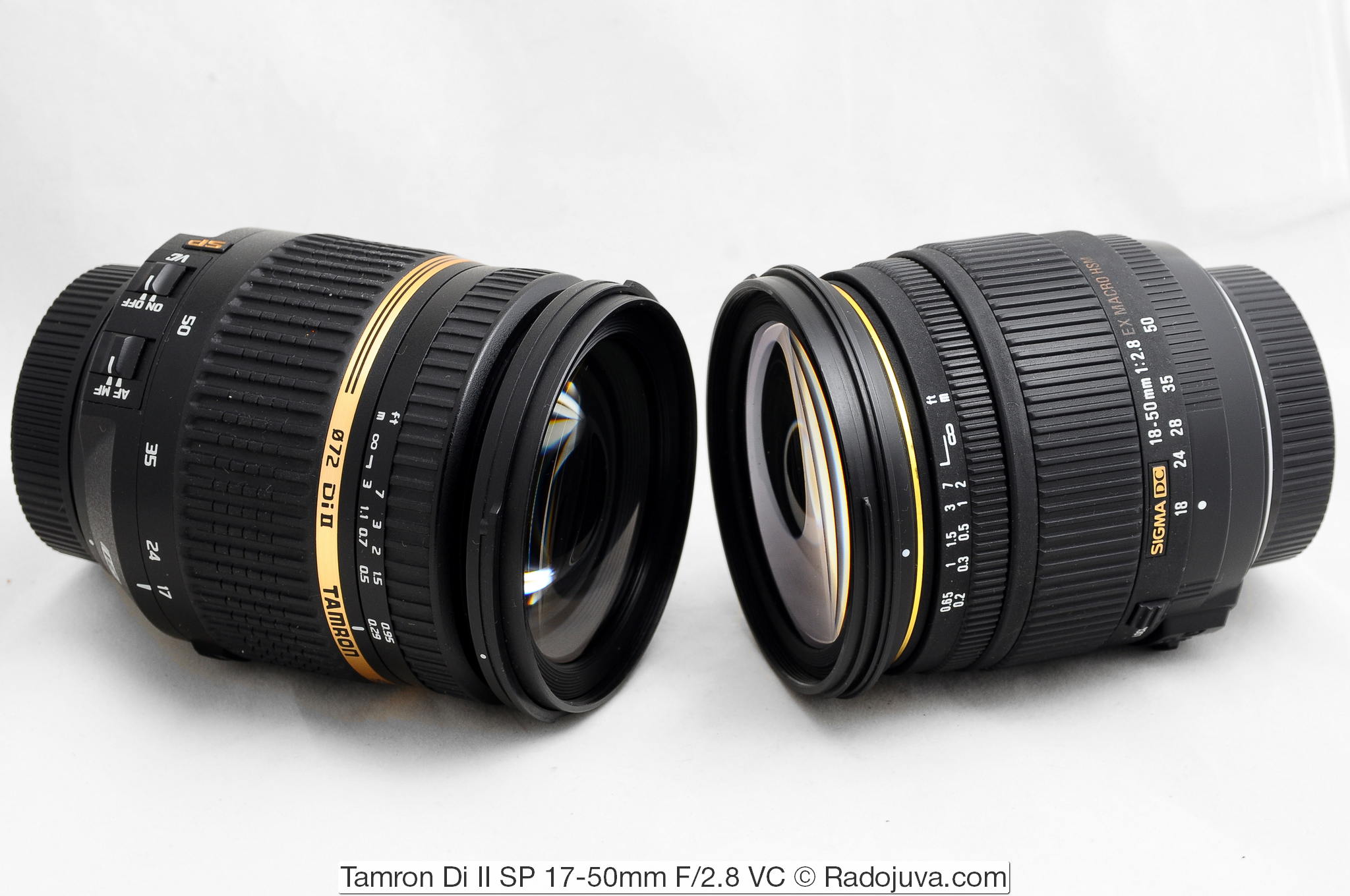
Tamron Di II SP 17-50mm F / 2.8 VC and Sigma DC 18-50mm 1: 2.8 EX MACRO HSM
Conclusions
Tamron Di II SP 17-50mm F / 2.8 VC - balanced versatile fast lens with convenient focal lengths for DX cameras and an image stabilizer. Suitable as a good staffer for DX cameras.
Material prepared Arkady Shapoval. Training/Consultations | Youtube | Facebook | Instagram | Twitter | Telegram

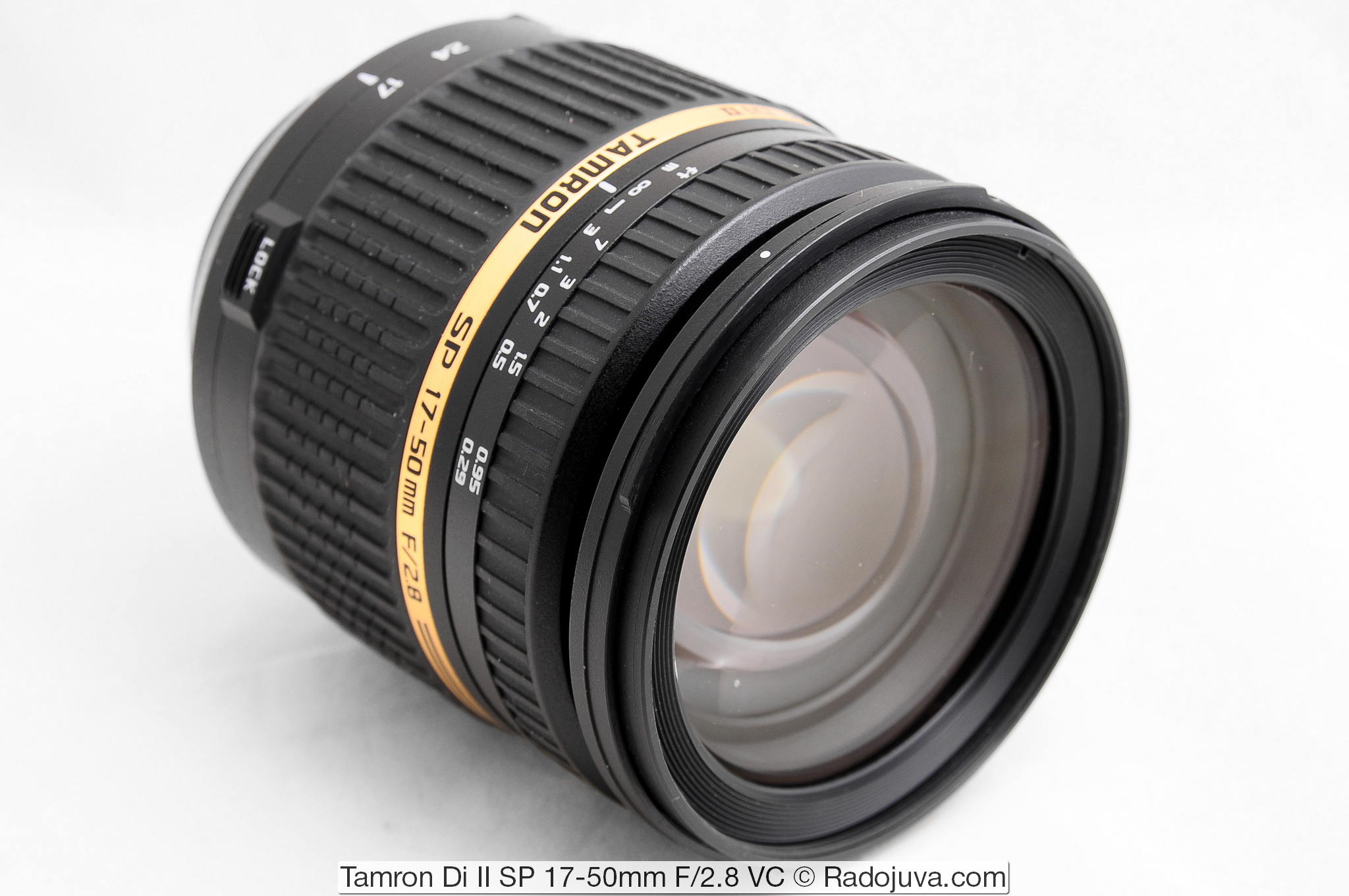
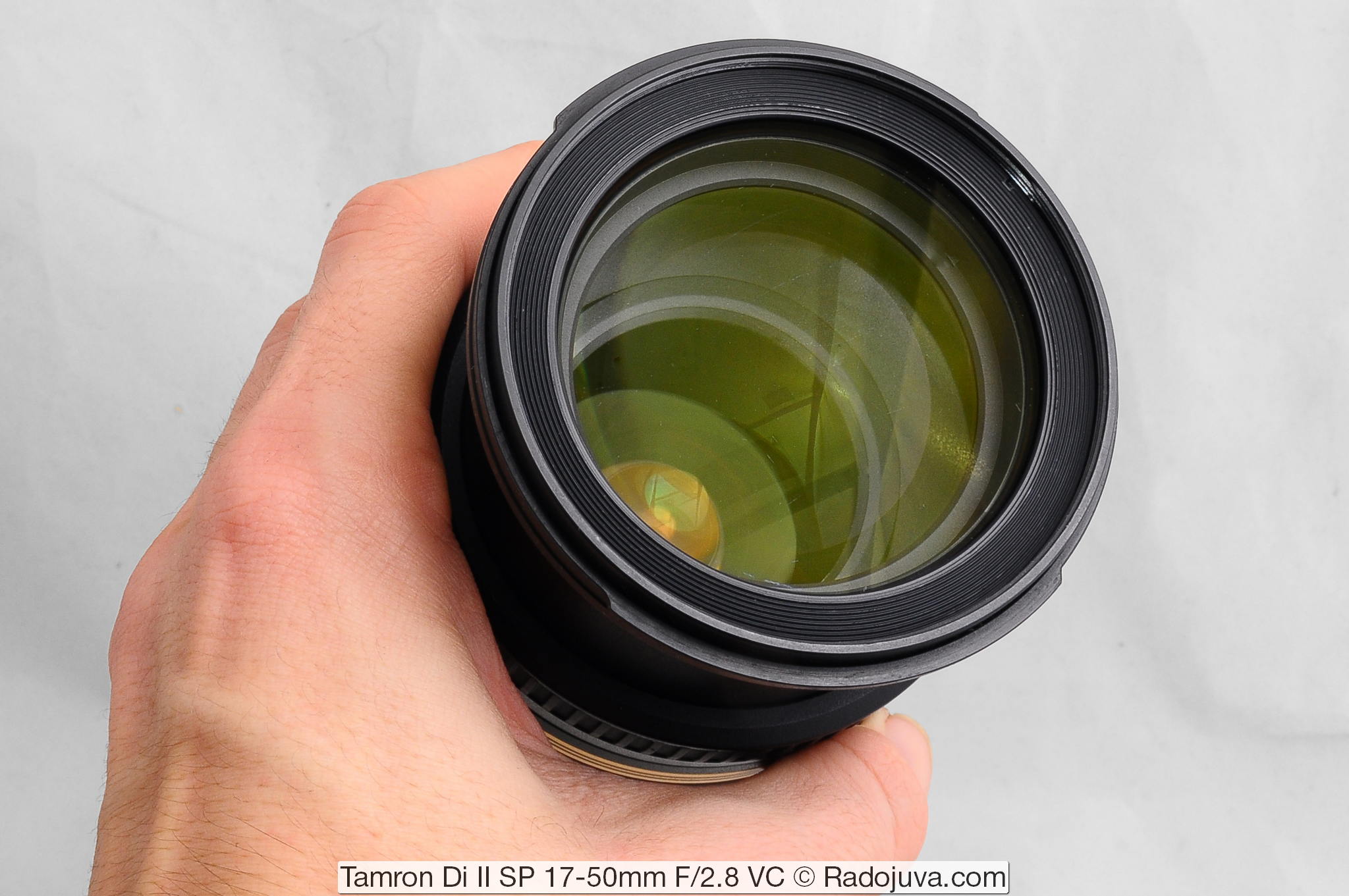
![Optical design SP AF 17-50mm F / 2.8 XR Di II VC LD Aspherical [IF]](https://radojuva.com/wp-content/uploads/2018/02/tamron-17-50-vc-optical-scheme-big-300x263.jpg)
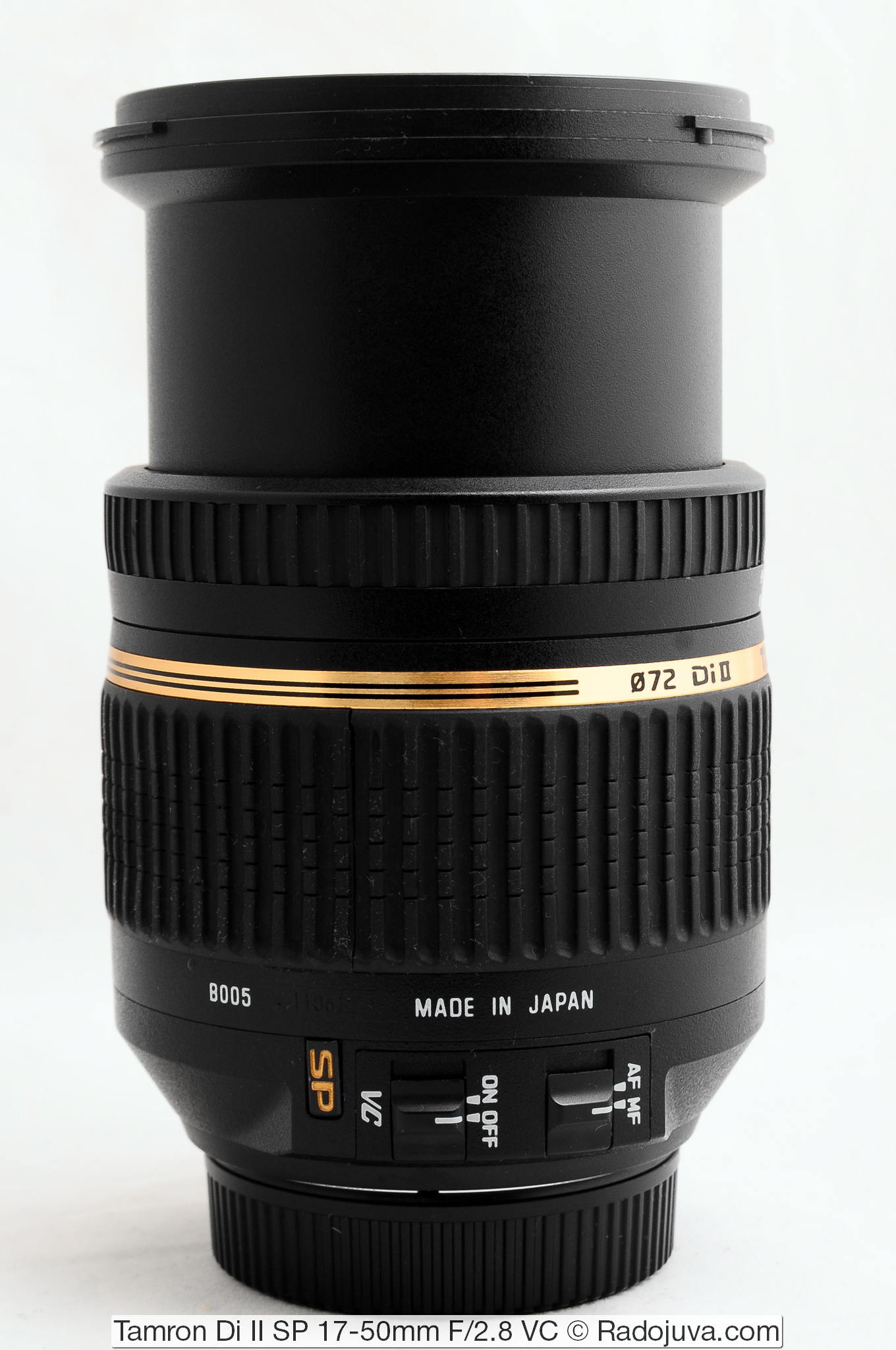

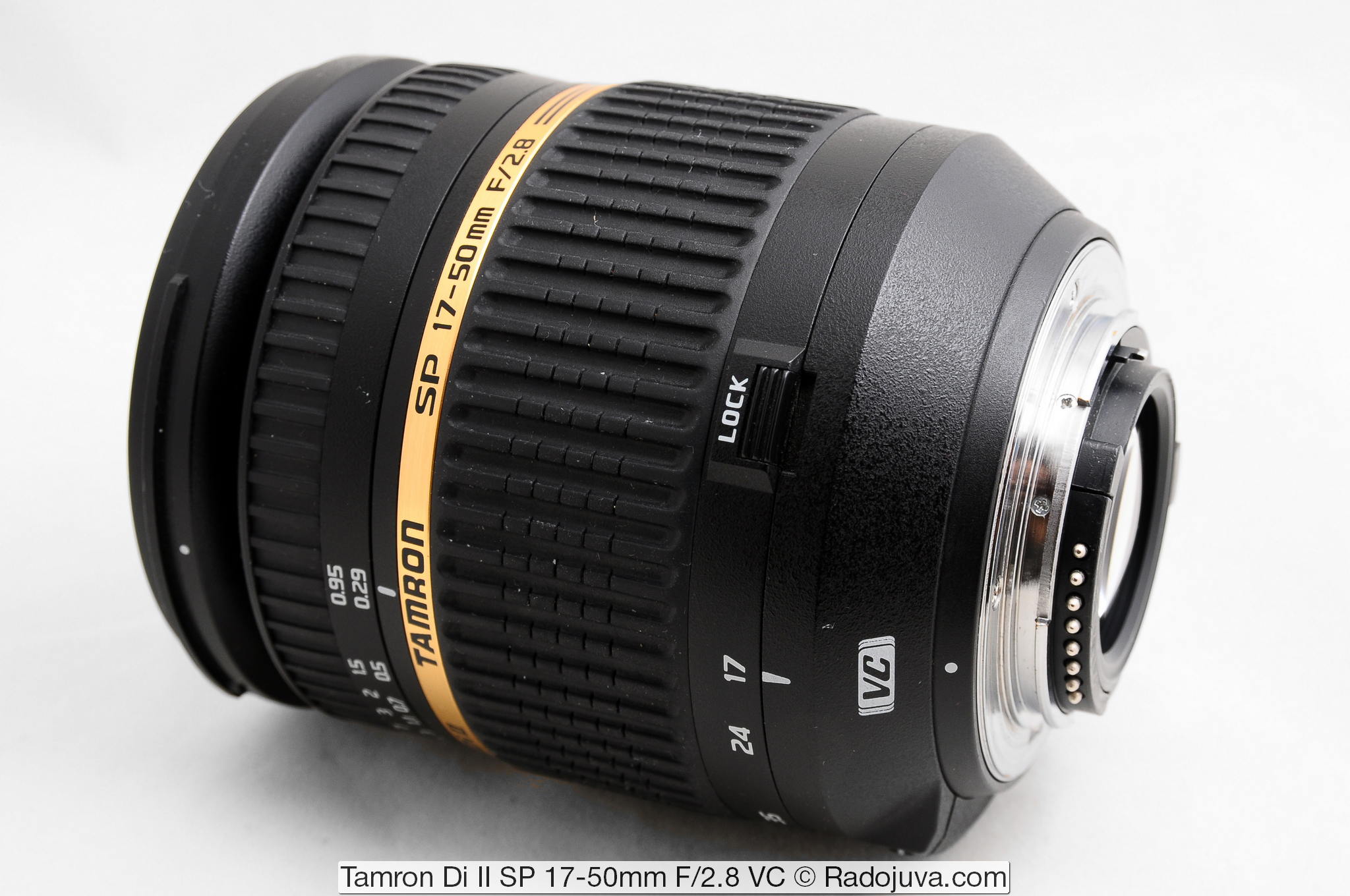
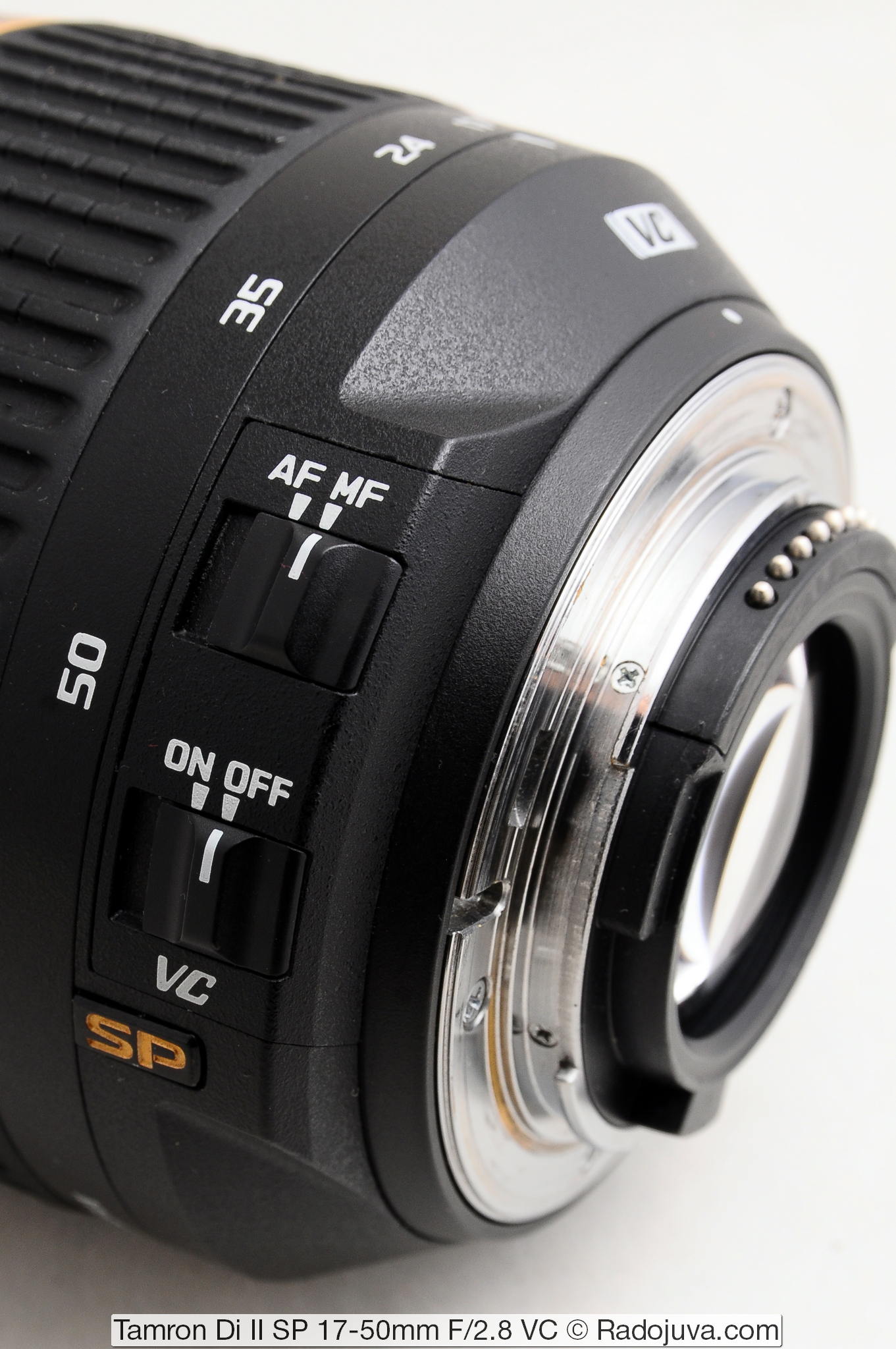
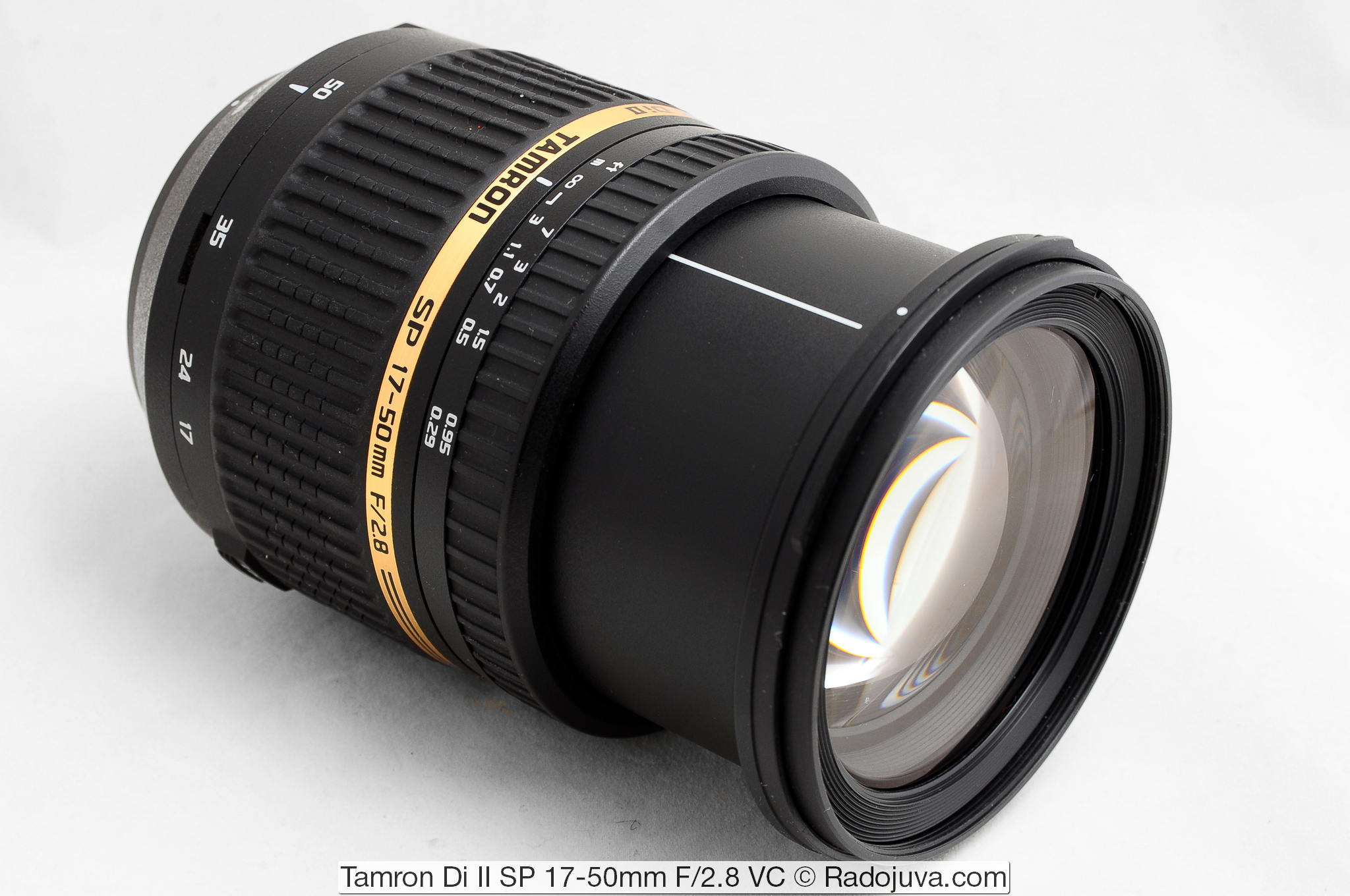






























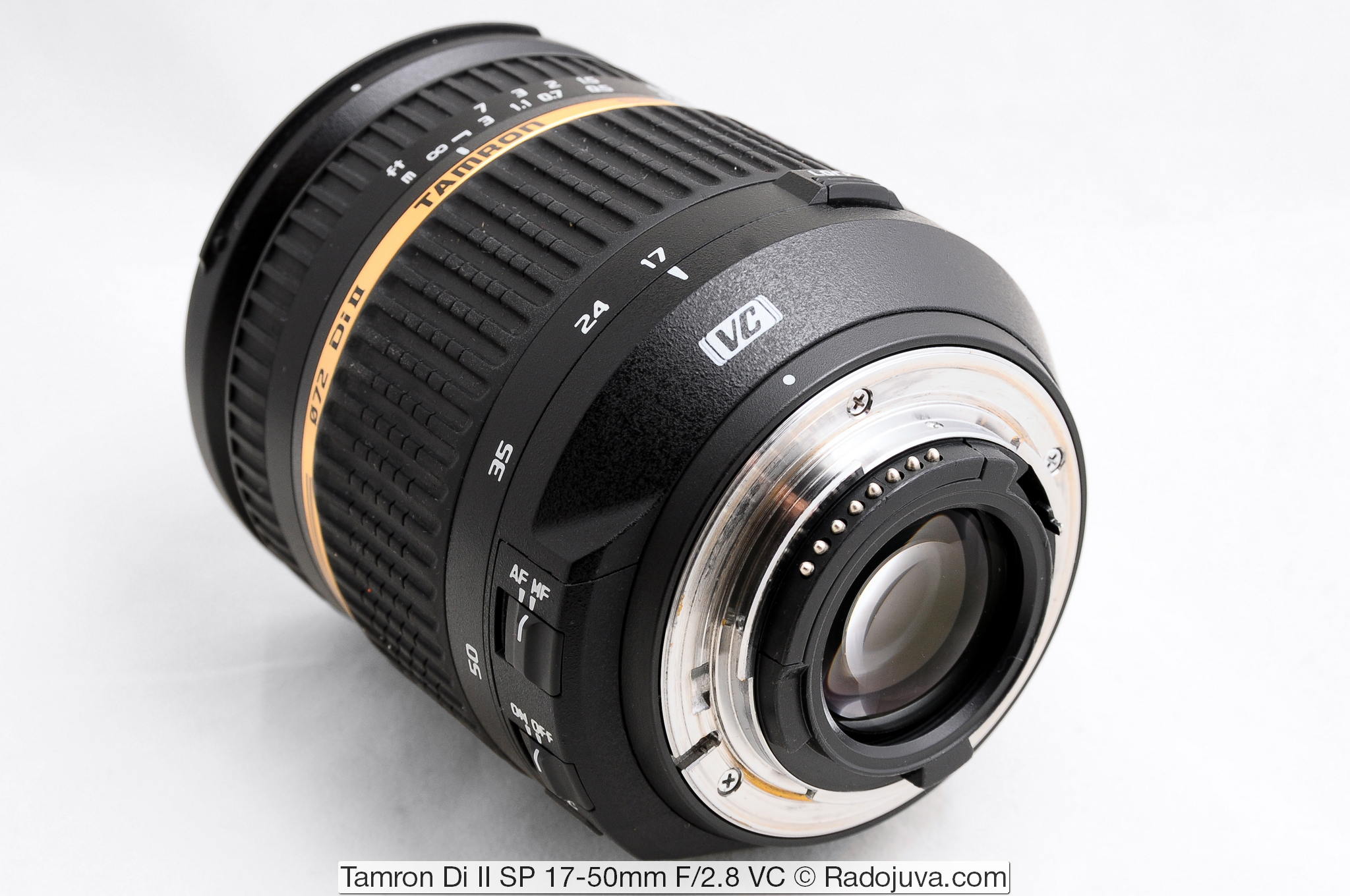

having bought such a bi
Great glass for the money was, my first full-time lens! However, I now agree with the guys https://buynbest.ru/luchshii-universalnyi-zum-obektiv-canon/ and I myself would recommend taking Sigma 18-35 1.8, it is at least more expensive, but it will be much better in quality, and in aperture ratio, and in terms of design.
I do not agree with you.
The fact is that Sigma 18-35 f1.8 is 3,5 times more expensive in the used glass market.
Moreover, the problems with whimsical autofocus, the weight of the lens, the focal lengths, and most importantly the price do not go plus Sigme.
In terms of price and quality, Tamron is a clear favorite among these two lenses.
If you stick to the issue of perfectionism and the absolute quality of the picture without regard to the cost of optics, then definitely Sigma Art.
I have been using this lens for 4 years now. I am very pleased with his qualities. Both technical and operational. He perfectly and without any whims copes with almost all genres of photography. and at the same time shows remarkable results! True, it says on its body that it was made in Japan ... For 4 years of intensive use, all units and mechanisms work flawlessly, nothing comes off (in spite of Nikkoram), nothing gets loose, everything is accurate, tight, smooth. The stabilizer does not really give the four compensation steps promised by the company, but it does two exactly. The optical drawing may seem to someone not outstanding, but it depends on what to compare ... At a focus of 50mm and o / o 2,8, soft in tonality, plastic images are obtained, on the one hand, with excellent sharpness, on the other, with smooth and very voluminous transitions to blur from the center to the edge. And although 50mm is not the best trick for portraits, Tamron does it perfectly! Yes, there is a drop in contrast to a small extent, but guys, just tweak it in the editor, and that's it! In all other respects, the description of Arkady is absolutely accurate, and the conclusion is correct: in terms of the combination of properties (including price), this lens is head and shoulders above its other competitors.
Most likely, you had in mind the old version without VC, since VC has been produced for less than 4 years.
Yes, you’re right. Indeed, I confused the number of years during which I have been using Tamron WITH A STABILIZER. Wrong for a year.
thanks a lot!!!!!
Thanks for the review!
The question is - can it serve as a replacement for the kit 18-55 in terms of price / quality?
Yes maybe.
The first thing that catches your eye = sharpness. Second, I don't know how it is with the front / back focus. They say that Tamron glass is like a lottery: either you are lucky or not. But I trust your opinion.
I have 17-50 without VC for one year already. The gum peeled off, the front bezel pinned, but it works well.
Arkady, it would be very interesting to know your review on Tamron SP 70-300mm F / 4-5.6 Di VC USD. 17-50 You already painted already 2 times, but the TV set is not there yet))
Thank you!
I will write as soon as possible.
Great review! thanks!!!
Good day. Arkadiy, having bought this object, is all cool if I know the video about turning on the stabilizer to make the noise, if it’s stable and autofocus - I don’t know, then, when looking at the PC, the rollers, even more noise. Tse so maє buti z tsim ob'єktivom what kind of marriage? In my colleague є Sigma 17-70, I do not care about that. I can yakis nalashtuvannya ob'єktivu. Don’t really help that stab nada for such a penny as a video of him, for a photo of that stabilizer it’s not necessary to look at it.
Crazy.
Only autofocus produces a lot of noise. The stabilizer should be quiet. To be sure what is noisy - first turn off autofocus on the lens and shoot a video. If there is no noise, then autofocus really makes noise. Otherwise, the stub makes noise.
So what is the objective of marriage?
It just works like that.
Arkadiy duju dyakuyu
arkady! I have a question for you!!! I shoot with this lens - I like everything, but there is one thing ... but when I shoot with a flash, in some places, mainly on my hair, the ends of my hair shine, it seems like they were silvered! and this happens only with him. is it a marriage? Or am I doing something like that ??? thanks!
There can be many variants of such an effect, if you sent a link to a snapshot, I would try to give an answer.
A big request in the examples, if possible, lay out a portrait, because rent 99% of people)))
I have been using it for 8 months, I’m satisfied, for weddings it’s the very thing. In churches, the stub is very helpful, with a zoom it is more convenient than with a fix, Nikkor is slightly inferior in speed, the price-quality ratio is excellent!
It would be better to read the Tamron vs Sigma vs Tokina test (17-50 / 2,8), but if you can.
I don’t have VC (Sony version), but I agree with all the thoughts of the author, a very good lens and given its price in Ukraine, it has practically no competitors,
which is interesting in terms of picture quality, it is better than Minolta 28 f2.8 fixes and the same sharpness as Sony 50 f1.8, but Tamron's color is better.
----------
http://photo-wed.blogspot.com/
There is just such ... I didn't have a mind I bought a carcass with a “whale”. Then I bought this one.
Especially not delighted. Somehow he did not seem much better than the "whale".
And for weddings, it's funny ... Except in a village somewhere.
Already there were thoughts of pushing it to someone and buying yourself something for the recently purchased canon.
http://www.mega-foto.ru/articles/11384/
Is it worth it to change Nikon 18-105mm ???
What tasks will you use for?
for filming birthdays, and similar holidays! If you're lucky, then weddings. Simply put portraits, etc.
I rent them just weddings, etc. Aperture helps out.
well, it's just that many users say that it is not sharp, and a slow focus, which very often misses (((
I wrote about this in the review, just read the review.
The fact of the matter is - I read, and I trust you more than rumors and stories of outside "experts" !!!!! Since I have checked many of your articles on personal experience and everything is fine! Once again, I just decided to insure myself with your efficient and smart advice! In short, everything is worth changing!
At one time, I also changed 18-105 to Tamron. But, I really chose from 3 options. Now I completely got off the gum of the zoom.
Well, do not regret the replacement ???
No, if this one dies (although I don’t believe in it) I’ll take myself with the stub an option https://radojuva.com.ua/2012/06/tamron-af-17-50mm-f2-8-vc/, or the same.
so I want to change with a stub !!!
And another question - with this 17-50 overexposure with a flash, how to avoid it? As I understand it, high-aperture lenses + flash need a special approach! Can you tell me how? Or maybe there is an article?
A counter question - why should there be overexposure?
Well, I have little experience in this, no matter how silly - just aperture + flash - so that there is not a lot of light!
Here is some information on how the flash works (it adjusts the power) https://radojuva.com.ua/2012/08/flesh-ttl-how-it-works/